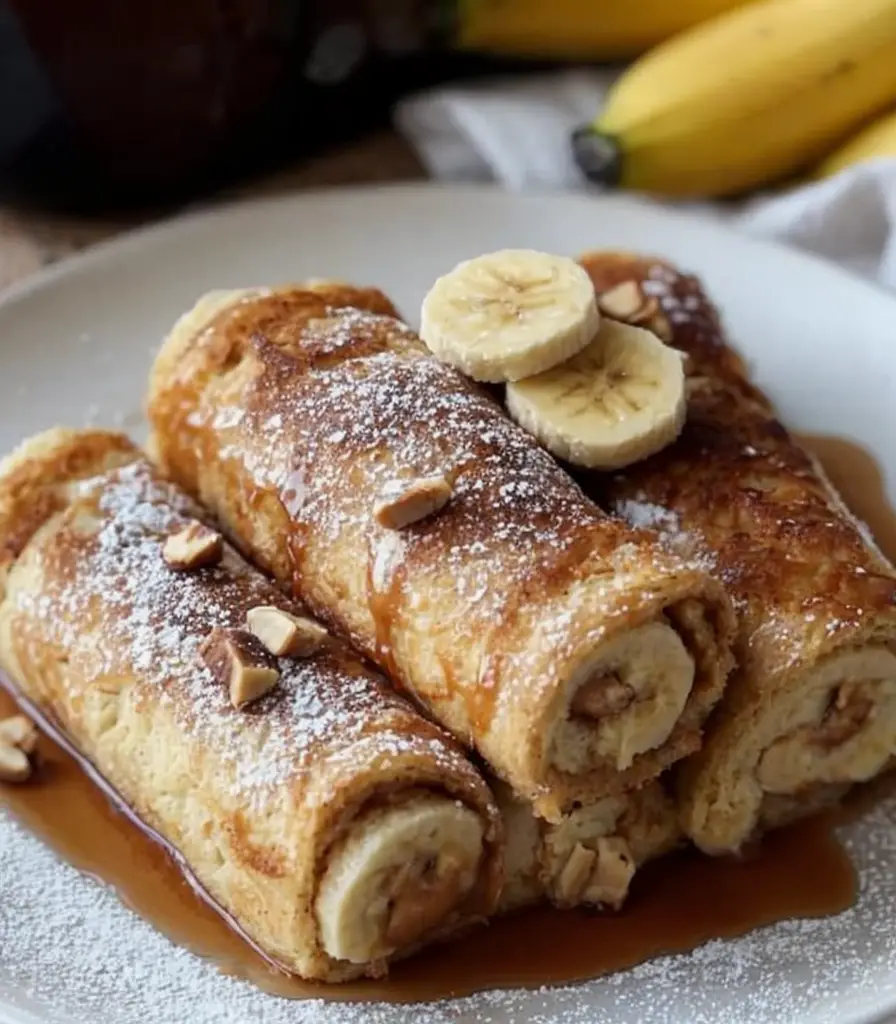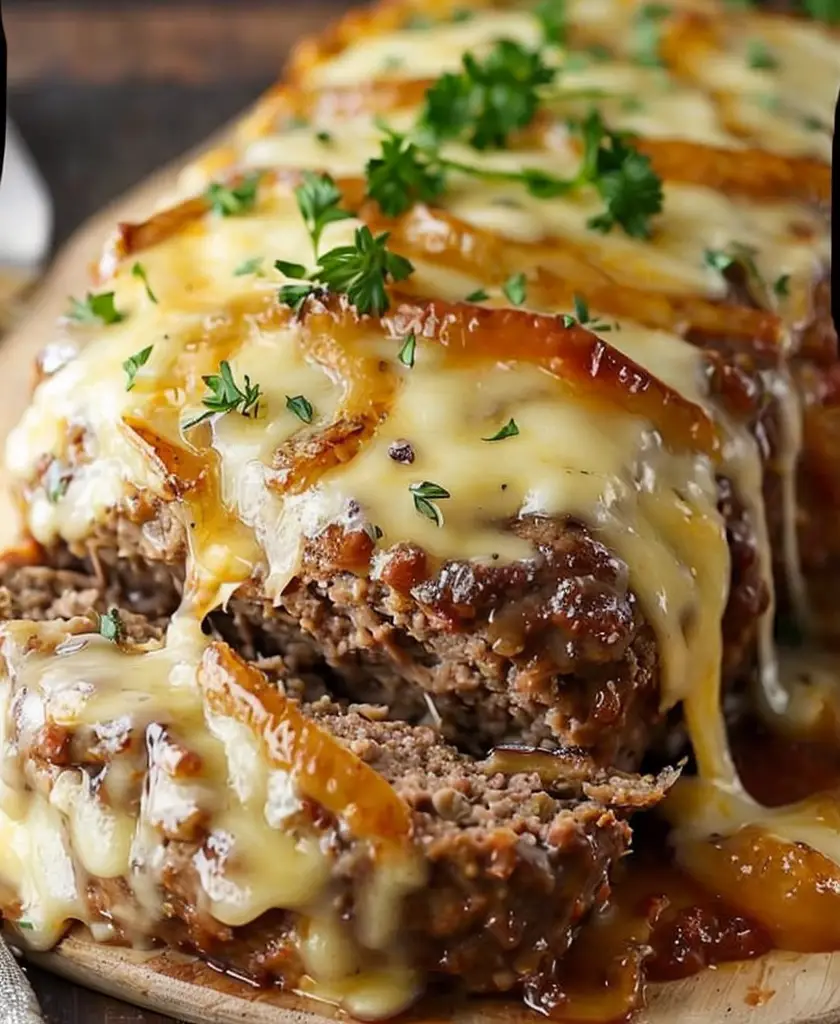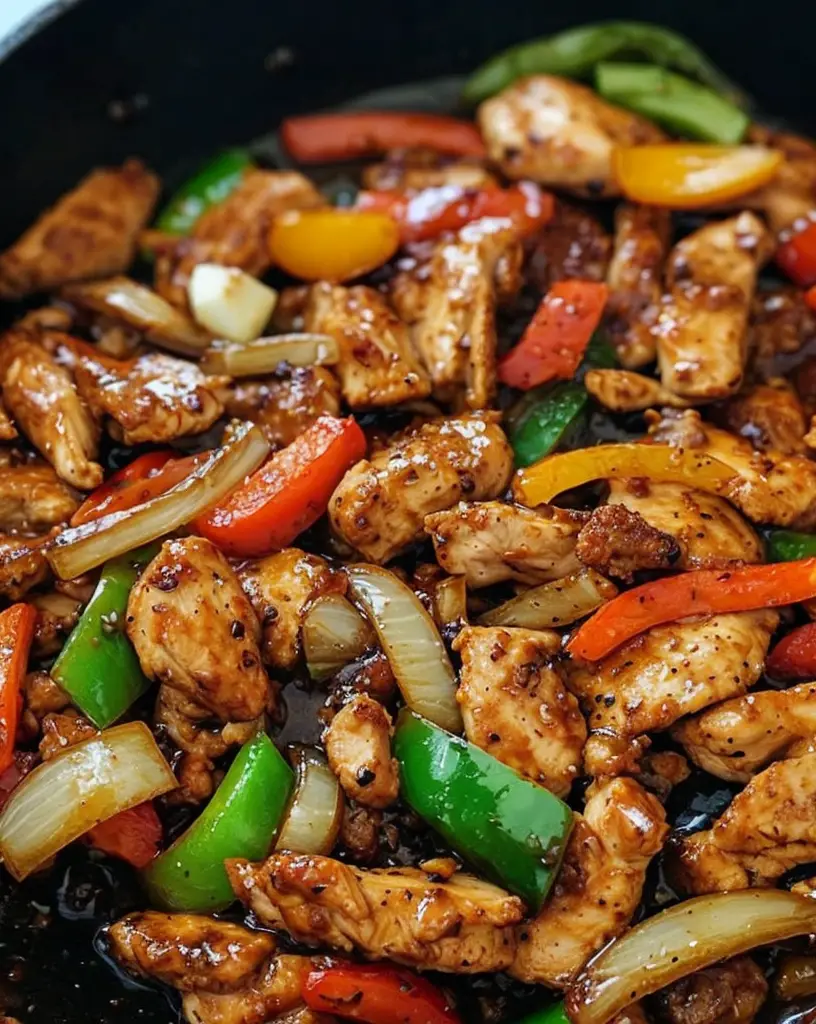Delicious Banana Peanut Butter French Toast Roll-Ups: A Breakfast Delight
If you’re looking for a delightful addition to your breakfast routine, these Banana Peanut Butter French Toast Roll-Ups are the perfect choice. This recipe features soft, sweet bananas and creamy peanut butter wrapped in crispy, golden-brown bread, all enhanced with a hint of cinnamon. Each bite is a heavenly combination of flavors that will satisfy your morning cravings while providing a nutritious boost to your day.
Not only are these roll-ups incredibly delicious, but they are also quick to prepare, making them an ideal option for busy mornings or leisurely brunches. The fun, roll-up format adds a playful twist to traditional French toast, appealing to both kids and adults alike. Serve them drizzled with warm maple syrup or topped with fresh fruits and whipped cream for a breakfast that feels indulgent but is easy to make.
Quick Recipe Highlights
- Flavor Profile: Sweet bananas and nutty peanut butter create a perfect balance with a hint of cinnamon.
- Texture: The crispy exterior contrasts beautifully with the creamy filling, making each bite satisfying.
- Aroma: The warm, inviting scent of cinnamon and toasted bread fills the kitchen, creating a welcoming atmosphere.
- Visual Appeal: These roll-ups are golden, inviting, and can be beautifully garnished with fresh fruit.
- Skill Level Needed: Perfect for beginners, as well as seasoned cooks looking for a quick and fun dish.
- Special Equipment: You will need a non-stick skillet and a rolling pin for easy assembly.
Recipe Overview
- Difficulty Level: This recipe is simple and straightforward, requiring minimal techniques and ingredients. It’s perfect for anyone who is new to cooking.
- Category: Ideal for breakfast or brunch, these roll-ups can also serve as a sweet snack or dessert option.
- Cuisine: Inspired by American breakfast traditions, this recipe incorporates classic flavors in a creative format.
- Cost: The ingredients used are economical, making this a budget-friendly option for families and individuals.
- Season: These roll-ups can be enjoyed year-round, especially when bananas are in season.
- Occasion: Perfect for casual family breakfasts, festive brunches, or even sleepover treats.
Why You’ll Love This Recipe
First and foremost, the taste and texture of Banana Peanut Butter French Toast Roll-Ups will impress anyone. The rich creaminess of the peanut butter pairs exquisitely with the sweet, soft bananas, all enveloped in the comforting embrace of lightly toasted bread. This combination not only satisfies your taste buds but also fills your belly, making it a wholesome start to any day.
Convenience is another advantage of this recipe. It takes just minutes to whip together all the ingredients and prepare these delectable roll-ups. Perfect for those who are short on time yet still want to enjoy a homemade breakfast, you can even prep them the night before!
Nutrition is not forgotten in this recipe. Bananas provide essential vitamins and minerals, while peanut butter is rich in healthy fats and protein. This makes the roll-ups not only a tasty treat but a nutritionally beneficial option as well.
Whether you are serving them to family or friends, these roll-ups have a social appeal that ignites conversation and joy around the breakfast table. They not only make a beautiful presentation on the plate but also invite everyone to dig in and share their favorite toppings and variations.
Finally, this recipe demonstrates cost-effectiveness. With simple ingredients that are readily available in most household pantries, you can create an impressive breakfast without breaking the bank.
Historical Background and Cultural Significance
The origins of French toast can be traced back to ancient times when people found ways to reuse stale bread. As cultures evolved, so did the recipes, and it became a popular breakfast option across various countries. The introduction of peanut butter, primarily in the United States in the 20th century, transformed many dessert and snack recipes, making it a staple in American kitchens.
In many cultures, breakfast is no mere meal; it’s a ritual that sets the tone for the day. In the U.S., combining peanut butter with familiar breakfast staples like bananas symbolizes comfort and homeliness, making these roll-ups not just food but a nostalgic experience.
This recipe reflects the evolution of breakfast dishes, showcasing how traditional elements can be reimagined to create something fun and new. By wrapping a classic French toast into a portable roll-up, it brings a fun twist to a beloved dish.
Regional variations of French toast exist worldwide, with each country typically adding its own local flavors and techniques. This recipe draws on the American preference for nut spreads, creating a fusion that speaks volumes about adaptability and creativity in cooking.
Ingredient Deep Dive
Bananas: Rich in potassium and dietary fiber, bananas have a tropical sweetness that many people love. They are versatile and can be used in baking, smoothies, or eaten fresh. When selecting bananas for this recipe, opt for those that are ripe but not overly soft to prevent them from turning too mushy.
Additionally, bananas can be stored at room temperature until ripe, after which they can be refrigerated to prolong freshness. If you have overripe bananas, consider using them in baking or smoothies as a delicious alternative.
Peanut Butter: This ingredient is a fantastic source of protein and healthy fats. Originating in the U.S., peanut butter has become a globally enjoyed pantry staple. When choosing peanut butter, look for natural brands that contain minimal additives and preservatives. Smooth peanut butter replicates a creamier texture, but chunky can add a delightful crunch.
Store peanut butter in a cool, dry place, and if you want to extend its life, refrigeration can be a good option. If you prefer, almond or sunflower seed butter can be excellent alternatives for those with nut allergies.
Common Mistakes to Avoid
- Over-soaking the bread, which can lead to soggy roll-ups with a mushy texture. Use the egg mixture sparingly to avoid this issue.
- Choosing overly ripe bananas; while they should be soft, extremely overripe fruit can lead to a messy filling.
- Cooking on too high a heat can burn the exterior while the inside remains uncooked. Opt for medium heat to ensure even cooking.
- Not allowing the skillet to heat sufficiently before adding the roll-ups, which may cause them to stick.
- Skipping the cinnamon, which adds essential flavor—it’s a crucial part of the French toast experience!
- Neglecting to chill the mixture, which may lead to uneven spreads of peanut butter and banana.
- Using stale or dry bread. Fresh bread that can hold moisture works best to create a soft interior.
- Not pressing the roll-ups firmly while cooking can cause them to unravel—ensure a gentle but firm grip when flipping.
- Serving them cold; a warm roll-up is delightful and helps revive the flavors.
- Overloading the filling can cause overflow during cooking, so keep it modest for best results.
Essential Techniques
Master the art of rolling by keeping the filling centralized. This prevents spillage and ensures even cooking. Gently flatten the bread with a rolling pin before assembling to create a thinner layer that rolls up more easily.
Another key technique is proper heat management. Start with medium heat and adjust as needed to ensure the exterior crisps without burning. Use a non-stick skillet or lightly greased pan to aid in the flawless flipping of your roll-ups.
Pro Tips for Perfect Banana Peanut Butter French Toast Roll-Ups
1. Use different types of bread for unique flavors, such as brioche or wraps, to add a delightful twist.
2. Experiment with flavored peanut butter like chocolate or honey for additional taste layers.
3. For added indulgence, drizzle melted chocolate or Nutella on top before serving.
4. Make extra roll-ups and freeze for a quick breakfast option later on!
5. Consider adding a sprinkle of nuts or granola in the filling for extra crunch and nutrition.
6. Pair with a protein like scrambled eggs to balance the sweetness and create a fuller meal.
7. Garnish with seasonal fruits like berries or kiwi for a colorful presentation.
8. Serve with a side of yogurt to enhance flavor and nutritional value.
Variations and Adaptations
For a chocolate lover’s delight, include a few chocolate chips along with the banana and peanut butter. This can transform your roll-ups into a dessert-like morning treat that feels indulgent yet comforting.
Seasonal adaptations can mean adding spiced apples or pumpkin puree in the autumn for a comforting fall variant that embraces the season’s flavors. Also, consider switching in almond or sunflower butter for those with nut allergies, providing a similar texture and flavor profile.
For a lighter option, try a low-carb bread or even zucchini-based wraps to keep the same filling while maintaining a low-carb approach. Additionally, gluten-free bread can ensure this recipe aligns with gluten-free dietary needs without sacrificing taste.
Lastly, consider serving these roll-ups with a light dusting of powdered sugar or a drizzle of maple syrup to enhance presentation, making them even more inviting!
Serving and Presentation Guide
When plating Banana Peanut Butter French Toast Roll-Ups, consider a simple, elegant arrangement that enhances their appeal. Stack them neatly in a pyramid or arrange them in a line, garnished with fresh fruits for a pop of color.
Drizzle with honey or maple syrup just before serving for an eye-catching finish, and a light sprinkle of cinnamon or powdered sugar can further elevate the presentation. Use vibrant berries or mint leaves as garnish for added freshness, ensuring an artistic and delicious showcase.
For added interest, serve the roll-ups alongside a small bowl of yogurt for dipping or drizzling. This not only offers a complementary flavor but also introduces a delightful contrast to the rich peanut butter.
Wine and Beverage Pairing
While these roll-ups are often enjoyed as a standalone breakfast treat, pairing them with the right beverages can elevate the experience. A light, fruity sparkling wine pairs beautifully with the sweetness of the roll-ups, making for an inviting brunch option.
For non-alcoholic alternatives, a freshly squeezed orange juice adds a refreshing citrusy note that balances the richness of the peanut butter. An iced coffee or chai latte can also complement this breakfast, enhancing the flavor profile while providing an energizing boost to your morning routine.
Storage and Shelf Life
To store leftover Banana Peanut Butter French Toast Roll-Ups, place them in an airtight container in the refrigerator for up to 3 days. When reheating, opt for an oven or skillet to maintain the crispiness of the exterior.
If you want to extend their lifespan, these roll-ups can be frozen. Wrap them individually in plastic wrap and place them in a freezer-safe bag for up to 2 months. To reheat, allow them to thaw in the refrigerator overnight before warming them in the oven.
Make Ahead Strategies
These delicious roll-ups are not only quick to make but also suitable for meal prep. Assemble the roll-ups and store them in the fridge for up to 24 hours before cooking. This allows the flavors to meld, making for an even tastier breakfast option.
For those in need of speed in the morning, you can cook them ahead of time and reheat in the skillet or microwave, adding a quick drizzle of syrup before serving for a fresh touch.
Scaling Instructions
To halve this recipe, simply use two pieces of bread and one banana instead of four slices and two bananas. Adjust the peanut butter accordingly for balanced flavor. For larger gatherings, feel free to double or triple the recipe by ensuring a larger cooking surface to accommodate all roll-ups simultaneously.
Take note of cooking times, as they may vary with larger batches, so always ensure even cooking by flipping regularly. Store any extras carefully, following the same guidelines for immediate and future consumption.
Nutritional Deep Dive
Each serving of Banana Peanut Butter French Toast Roll-Ups provides a balanced macro breakdown. The combination of carbohydrates from the bread, fats from the peanut butter, and proteins from eggs creates a satisfying meal that fuels your day.
This recipe also boasts a good supply of micronutrients, including potassium from bananas and vitamin E from peanut butter. A comprehensive analysis will reveal that these roll-ups support energy levels, muscle function, and overall health.
Dietary Adaptations
For a gluten-free version of these roll-ups, swap regular bread for gluten-free bread options available in most stores. Ensure that all additional ingredients, particularly sauces and condiments, are also gluten-free.
Going dairy-free? Just choose a non-dairy milk substitute in the egg mixture, and enjoy the loves of this delicious breakfast item. A vegan approach can be realized using a plant-based alternative to eggs and nut butters that comply with vegetarian lifestyles.
Troubleshooting Guide
If your roll-ups turn out too soggy, ensure you’re not over-soaking the bread. Use enough egg mixture to coat but not saturate the slices. If the filling spills out while cooking, reduce the amount you place inside each roll to prevent overflow.
Should you encounter burning on the outside while the inside remains cold, check your heat settings; cooking them on lower heat for a longer time ensures an even cook. Adjust the cooking times based on thickness of the bread you’re using to avoid uneven results.
Recipe Success Stories
Community feedback has shown that many families love to make this recipe together, creating cherished moments over breakfast. Readers frequently share their adaptations, such as using flavored nut butters or adding chocolate chips, highlighting the recipe’s versatility.
Many have reported success in creating this dish not just for breakfast but also for dessert, showcasing its adaptability in different mealtimes. The ease of preparation has encouraged readers to make this a staple for when guests come to visit.
Frequently Asked Questions
Can I use other fruits instead of bananas?
Absolutely! Berries, peaches, or apples can be great substitutes. Just ensure they are cut into small pieces for easier rolling.
What type of bread is best to use?
White sandwich bread, whole grain, or even brioche work great. Choose a bread that you enjoy and stays fresh for optimal results.
Can I make these roll-ups ahead of time?
Yes, you can assemble them the night before and store in the fridge. Just cook them fresh in the morning for the best texture.
What other spreads can I use instead of peanut butter?
You can substitute with almond butter, Nutella, or even a yogurt spread for a different flavor profile.
Are these roll-ups suitable for freezing?
Yes, they freeze well! Wrap individually and store in a freezer-safe container or bag. Reheat when ready to enjoy!
Can I omit the cinnamon?
While cinnamon adds warmth and flavor, you can omit it if you prefer. You may also choose to substitute with nutmeg for a different aromatic experience.
How do I know when they are done cooking?
They should be golden brown and crispy on the outside. The filling should be warm without any cold spots inside.
What can I top them with?
Options are endless! Consider fresh fruit, whipped cream, syrup, or even a dusting of powdered sugar for added sweetness and flair.
Can I make these roll-ups vegan?
Yes! Use plant-based egg substitutes and coconut or almond milk for the batter; other than that, follow the recipe as directed.
Is this recipe kid-friendly?
Absolutely! Kids love rolling their own and can help choose fillings, making it a fun family activity.
Additional Resources
For more delightful breakfast ideas, check out our other recipes featuring family favorites. Explore technique guides that delve into mastering the art of breakfast and ingredient information that highlights the nutritional benefits of classic ingredients. Don’t forget to browse equipment recommendations to make your cooking experience even easier.
Join the Conversation
We’d love to hear your thoughts about these Banana Peanut Butter French Toast Roll-Ups. Share your photos on social media and tag us for a chance to be featured! Join our community by leaving a review of your experience, and let us know about your unique variations. Together, let’s celebrate the joys of cooking and create delicious memories through food.
The Recipe
Banana Peanut Butter French Toast Roll-Ups
Serves: 4
Prep Time: 10 mins
Cook Time: 15 mins
Total Time: 25 mins
Kitchen Equipment Needed
- Non-stick skillet
- Rolling pin
- Mixing bowl
- Spatula
- Measuring cups and spoons
Ingredients
- 4 slices of bread
- 1 large banana, sliced
- 1/4 cup peanut butter
- 2 eggs
- 1/4 cup milk (or plant-based alternative)
- 1 teaspoon cinnamon
- Butter or oil for frying
- Maple syrup for serving
Directions
- In a mixing bowl, whisk together eggs, milk, and cinnamon.
- Flatten each slice of bread using a rolling pin. Spread peanut butter evenly, followed by a line of banana slices.
- Roll each slice tightly and secure with a toothpick if necessary.
- Heat a non-stick skillet over medium heat and add butter or oil.
- Dip each roll-up into the egg mixture, coating thoroughly, then place in the skillet seam side down.
- Cook until golden brown and crispy, 3-4 minutes on each side.
- Remove toothpicks if used, and serve warm with maple syrup.
Recipe Notes
- For added flavor, consider incorporating a pinch of nutmeg into the egg mixture.
- These roll-ups can be customized with different nut butters or additional fillings like chocolate chips or nuts.
- Leftovers can be stored in the refrigerator and reheated for convenience.




